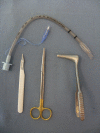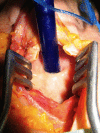Emergency cricothyroidotomy performed by inexperienced clinicians--surgical technique versus indicator-guided puncture technique
- PMID: 22843552
- PMCID: PMC3717590
- DOI: 10.1136/emermed-2012-201493
Emergency cricothyroidotomy performed by inexperienced clinicians--surgical technique versus indicator-guided puncture technique
Abstract
Background: To improve the ease and safety of cricothyroidotomy especially in the hand of the inexperienced, new instruments have been developed. In this study, we compared a new indicator-guided puncture technique (PCK) with standard surgical technique (ST) regarding success rate, performance time and complications.
Methods: Cricothyroidotomy in 30 human cadavers performed by 30 first year anaesthesia residents. The set chosen for use was randomised: PCK-technique (n=15) and ST (n=15). Success rates, insertion times and complications were compared. Traumatic lesions were anatomically confirmed after dissection.
Results: The ST-group had a higher success rate (100% vs 67%; p=0.04). There was no difference in time taken to complete the procedure (PCK 82 s. vs ST 95 s.; p=0.89). There was a higher complication rate in the PCK-group (67% vs 13%; p=0.04). Most frequent complication in the PCK-group was injury to the posterior tracheal wall (n=8), penetration to the oesophageal lumen (n=4) and injury to the thyroid and/or cricoid cartilage (n=5). In the ST-group in only 2 cases minor complications were observed (small vessel injury).
Conclusions: In this human cadaver study the PCK technique produced more major complications and more failures than the ST. In the hand of the inexperienced operator the standard surgical approach seems to be a safe procedure, which can successfully be performed within an adequate time. The PCK technique cannot be recommended for inexperienced operators.
Keywords: Cricothyroidotomy; airway; anaesthesia; difficult airway management; emergency departments; equipment evaluation; management; puncture technique; standard surgical technique; surgical airway; training.
Conflict of interest statement
Figures
Similar articles
-
Cricothyroidotomy: comparison of three different techniques on a porcine airway.Anaesth Intensive Care. 2009 Nov;37(6):961-7. doi: 10.1177/0310057X0903700602. Anaesth Intensive Care. 2009. PMID: 20014603
-
A comparison of two emergency cricothyroidotomy kits in human cadavers.Anesth Analg. 2008 Jan;106(1):182-5, table of contents. doi: 10.1213/01.ane.0000296457.55791.34. Anesth Analg. 2008. PMID: 18165576
-
Emergency cricothyrotomy-a comparative study of different techniques in human cadavers.Resuscitation. 2009 Feb;80(2):204-9. doi: 10.1016/j.resuscitation.2008.10.023. Epub 2008 Dec 5. Resuscitation. 2009. PMID: 19058897
-
Emergency cricothyrotomy.Mil Med. 2003 Jul;168(7):541-4. Mil Med. 2003. PMID: 12901463 Review.
-
Awake Cricothyrotomy: A Novel Approach to the Surgical Airway in the Tactical Setting.Wilderness Environ Med. 2017 Jun;28(2S):S61-S68. doi: 10.1016/j.wem.2017.02.003. Wilderness Environ Med. 2017. PMID: 28601212 Review.
Cited by
-
Needle Cricothyroidotomy by Intensive Care Paramedics.Prehosp Disaster Med. 2022 Oct;37(5):625-629. doi: 10.1017/S1049023X22001157. Epub 2022 Aug 12. Prehosp Disaster Med. 2022. PMID: 35959773 Free PMC article. Review.
-
Comparison of a percutaneous device and the bougie-assisted surgical technique for emergency cricothyrotomy: an experimental study on a porcine model performed by air ambulance anaesthesiologists.Scand J Trauma Resusc Emerg Med. 2013 Jul 26;21:59. doi: 10.1186/1757-7241-21-59. Scand J Trauma Resusc Emerg Med. 2013. PMID: 23890359 Free PMC article.
-
Cadaveric emergency cricothyrotomy training for non-surgeons using a bronchoscopy-enhanced curriculum.PLoS One. 2023 Mar 23;18(3):e0282403. doi: 10.1371/journal.pone.0282403. eCollection 2023. PLoS One. 2023. PMID: 36952528 Free PMC article.
-
Randomized controlled trials of simulation-based interventions in Emergency Medicine: a methodological review.Intern Emerg Med. 2018 Apr;13(3):433-444. doi: 10.1007/s11739-017-1770-1. Epub 2017 Nov 16. Intern Emerg Med. 2018. PMID: 29147942 Review.
-
Favour the best in case of emergency cricothyroidotomy-a randomized cross-over trial on manikin focused training and simulation of common devices.PeerJ. 2024 Aug 23;12:e17788. doi: 10.7717/peerj.17788. eCollection 2024. PeerJ. 2024. PMID: 39193513 Free PMC article. Clinical Trial.
References
-
- American Society of Anaesthesiologists Task Force on Management of the Difficult Airway Practice guidelines for management of the difficult airway: an updated report by the ASA Task Force on management of the difficult airway. Anaesthesiology 2003;98:1269–77 - PubMed
-
- Henderson JJ, Popat MT, Latto IP, et al. Difficult airway society guidelines for the management of the unanticipated difficult intubation. Anaesthesia 2004;59:675–94 - PubMed
-
- Wong DT, Lai K, Chung F, et al. Cannot intubate-cannot ventilate and difficult intubation strategies: results of a canadian national survey. Anesth Analg 2005;100:1439–46 - PubMed
-
- Sagarin MJ, Barton ED, Chng YM, et al. ; National Emergency Airway Registry Investigators Airway managament by US and Canadian emergency medicine residents: a multi-center analysis of more than 6,000 endotracheal intubation attempts. Ann Emerg Med 2005;46:328–36 - PubMed
-
- Cho J, Kang GH, Oh YM, et al. Comparison of manikin versus porcine model in cricothyrotomy procedure training. Emerg Med J 2008;25:732–4 - PubMed
Publication types
MeSH terms
LinkOut - more resources
Full Text Sources



